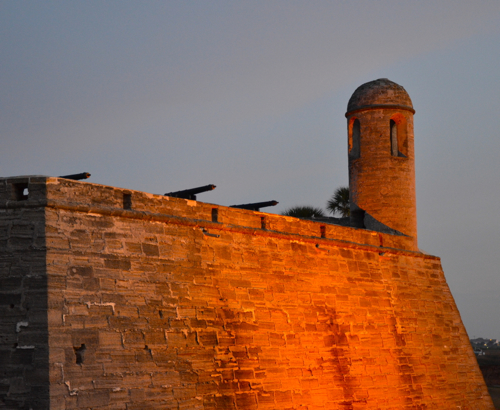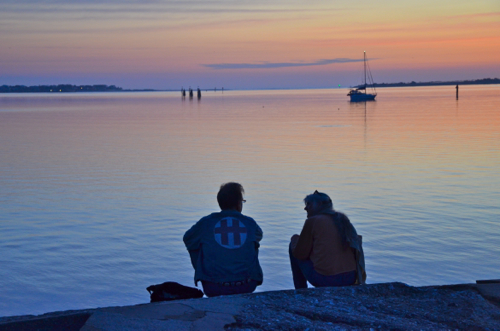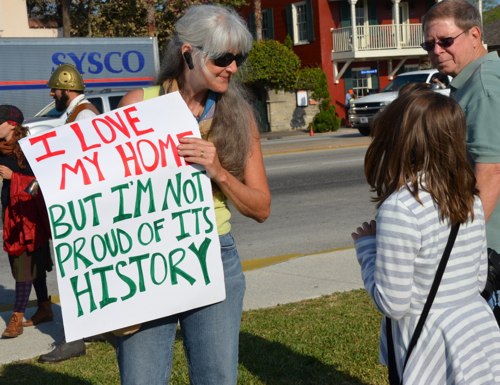This week, Florida celebrated the landing of Juan Ponce de Leon on her shores 500 years ago. The conquistador and former shipmate of Christopher Columbus sailed 1400 plus nautical miles from Puerto Rico to claim this "uninhabited" new world for Spain in 1513. He had more gold on his mind, having been wildly successful at subduing the Taíno indigenous peoples and forcing them into slavery in the mines. For this, de Leon was named Governor and Captain-General of Puerto Rico.

Castillo de San Marcos National Monument and Indigenous Prisoner of War Facility (Photo: G. Nienaber)
In spite of this sordid backstory, the city of St. Augustine pulled out all the stops to mark the "discovery" of Florida, beginning with a reenactment of the Spaniard's landing at the Castillo de San Marcos National Monument. The mayor of St. Augustine was present for a wreath laying, as was the Mayor of Santervás, Spain, the birthplace of Ponce de Leon. The Bishop of the Roman Catholic Diocese of St. Augustine blessed the event, and cross-carrying acolytes of the Church met the actor who played the Spanish conquistador. The Bishop also blessed a new baptismal font at the cathedral; a replica of the font that baptized Ponce de Leon. Meanwhile, the press was arguing about whether St. Augustine was "the" official landing site, or whether Melbourne beach deserved bragging rights.
Attorney Chase Iron Eyes of Last Real Indians issued a video statement in support of indigenous rights and in condemnation of the Spanish Requerimiento, a document that was read by Spanish military invaders to indigenous people as a declaration of war and sovereignty. God was ruler over the earth, and Spain was hell-bent, through papal authority, to take the Americas for Spain.
Still, 200,000 voices were missing at the festivities.
While a few hundred tourists whipped out iPhones, and cannons boomed from the ramparts of the Castillo, dolphins jumped and sang in the bay--dolphins that are descendants of the same dolphins revered by the Timucua people who welcomed Ponce de Leon to their shores.
Florida was not uninhabited in 1513. But the presence of 200,000 Timucua over 19,000 square miles presented a problem for the Europeans, especially conquistadors who followed Ponce de Leon. In 1539, Hernando de Soto entered Timucua territory and the stories of raping, murder and slavery can't be found in the local tourist guides. By 1595 only 50,000 Timucua remained, and in 1700 the ancient civilization was reduced to 1000. British colonists managed to wipe them out by the middle of the nineteenth century.
Extinction finally embraced the Timucua.
But what is extinction? Can you eradicate memory? Can you pave over sacred ground and declare it no longer exists? Can the Timucua experience a resurrection in this Christian season of Easter?

Bearing witness for the Timucua at sunrise at Castillo de San Marcos National Monument (Photo: G. Nienaber)
A local man, Casey Leydon, realized the Timucua would have no voice in the official celebrations of the history of Florida, so he decided to do something about it. It only takes one person to launch an idea and you can't kill ideas. An idea can never face extinction. Why not mark this day as the end of 500 years of genocide of indigenous people, and rededicate the Castillo as an International Native American Memorial? April 2 could become a day of healing and atonement. Put the call out there and see who shows up. There might be only one or two, but like the indigenous scouts, one or two can signal the advance of a multitude. So he started a Facebook page, wrote some articles, and immediately got over 1000 followers.
Suggest it, and they might come.
Having a colorful past for "criminal mischief" due to an arrest for a graffiti episode, it was doubtful whether Leydon would get a permit for his dedication ceremonies. But sometimes an idea takes hold in spite of all opposition-- in spite of attempts to murder the truth and whitewash history.
Rangers from the National Park Service unexpectedly showed up on Leydon's doorstep in St. Augustine and gave him a permit for his day of healing at the Castillo de San Marcos, and its rededication, in spirit, as a memorial. One of the Rangers was a woman who has worked extensively with indigenous people throughout the National Park System. She doesn't want her name used, but she offered empathy for the pain and suffering caused by the destruction of sacred sites.
This female Ranger showed up at sunrise near the Castillo and literally presented an outstretched hand to those trying to scramble up and over the seawall. Friendly and open, this representative of government authority spent the better part of an hour listening and describing her own experiences in the great western parks of the United States. Then, putting sunglasses firmly in front of her eyes, perhaps to hide her soul, she stiffened her spine and warned the few who were gathered that any mischief would result in consequences--from her. Authority had returned, but it was authority tempered with wisdom and understanding.
It only takes one scout.
Castillo de San Marcos is the oldest masonry fort in the continental United States and it rests on sacred ground. Its coral walls were built with indigenous slave labor, and after Spain ceded Florida to the United States, the fort was used as a prison for indigenous people, including the Seminole, Cheyenne and Geronimo's Chiricahua Apache.
A tourist book, Stories of Old St. Augustine, describes the Castillo as "a gathering point" for 500 Apaches who had "been making life miserable for the settlers in Arizona," and had been "removed by the U.S. Army to a place where they could be "watched and kept from doing any more damage."
Life was swell at the prison camp, and "each Indian family had its own tent and the women managed quite well at keeping house." Prepared in 2005 by a former editor in the Copyright Office of the Library of Congress, the "history" of St. Augustine might need some revision as an educational document.
This video offers a more realistic assessment of life for the people held as prisoners of war in their own homelands, and is currently on view at the National Museum of the American Indian in Washington DC. There are also photos of Apache at the Castillo.
Healing from this will take more than determination, it will take magic.
Leydon maintains that the dolphins that gather at sunrise near the bay front wall at the Castillo remember the songs sung by the Timucua. Is this magical thinking? There is no empirical evidence that dolphins sing songs acquired through memory. There is also no evidence that they do not. As the human mind has evolved, so has science. What we imagine often turns out to have a basis in science. Genetic memory and to a lesser extent, water memory, are becoming mainstream concepts.
What is certain is that the land under the Castillo was sacred ground in 1513 and sacred ground is the spiritual right of indigenous cultures. It cannot be legislated into oblivion by governments or tourism councils.
Native American author, scholar and orator, Winona LaDuke discusses this concept in Recovering the Sacred.
In the end there is no absence of irony: the integrity of what is sacred to Native Americans will be determined by the government that has been responsible for doing everything in its power to destroy native American cultures.
But is this the end game? Is it possible that bearing witness to the sacred produces miracles?

Questioning the Past (Photo: G. Nienaber)
I don't know. What I do know is that Leydon's vision drew a park ranger, healers, activists and a possibly a pod of dolphins to a forgotten sacred site. A woman dream healer brought prayers, and some activists with anger issues presented anger and street theatre for the television cameras. Anger is easy to generate, healing takes more thought and effort.
Curiosity drew a young white girl who was at the city's celebration with her mother. She approached one of the protesters and said she was aware of what had happened to the indigenous people and did not even want to come to the event. It made her "sad."
It only takes one scout.
